Stockholm, 23 April 2001
European Consultative
Forum on the Environment and Sustainable Development:
TOWARDS A SUSTAINABLE EUROPE IN A GLOBAL
Measuring
sustainability:
From Cardiff to Gothenburg
Domingo
Jiménez-Beltrán
Executive Director
European Environment Agency
1. Indicators as a support to policy making
The Swedish Presidency has already achieved a lot
in promoting integrated policy making: the discussions at the Stockholm
European Council and the large amount of preparatory workshops towards
these and next Council meetings reflect a firm line towards integration
of policies and transparency and accountability of policy making.
One of the recurring themes is that policies and strategies should go
with indicators for judging progress made. It is at this point that the
European Environment Agency comes into the picture.
The European Environment Agency (EEA) is a European
Community body with the aim of serving the Community and the Member
States with information to support policy making for environmental
protection in the perspective of sustainable development. We do that by
collecting and assessing data on the current and foreseeable state of
the environment.
With the development in attention going from ‘environment', to ‘the
environmental pillar in sustainable development' to ‘environmentally
sustainable development' we are in a constant process of creating clear
lines for our clients focusing on the essentials in the overload of
environmental and sustainability information.
Our primary clients are policy-making agents and politicians at EU
level in the European Commission, in the European Parliament, in the
Council and in the Member states. Not only the Swedish Presidency but
also others are increasingly aware of the use of and usefulness of
indicators in their processes. Indicators can play an important role
within the policy preparation and the evaluation stages of the policy
cycle (figure 1).
Figure 1:
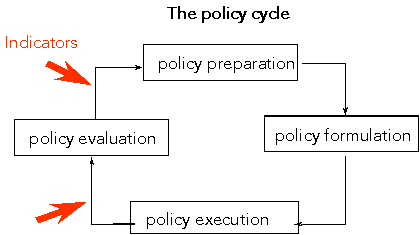
However, our primary clients are not the only
actors driving policies and able to bring along changes. Informed
citizens, NGOs, companies, lower levels of governments are our
secondary target groups.
Their indicator needs are partly similar to politicians and policy
makers as they are also participating in the decision-making process,
although in different ways. These groups will use the indicators
primarily to make the policy makers accountable for their actions to
face environmental challenges. As such they will use "conventional”
indicators such as energy efficiency, greenhouse gas emissions, or
vehicle kilometres driven. But apart from these, citizens groups ask
for indicators that have a more radical character. It is the NGOs that
have brought concepts like ecological footprint, foodmiles, green GDP
further in attempts to get tools that are able to raise attention not
for a single environmental problem, but for the basic processes behind
environmental degradation, viz. international trade, specialisation,
uncovered external costs.
But, regardless the way the indicators are defined, a few principles
seem needed to make them work:
- Indicators should report progress over time and must go with an
assessment of the reasons for their development.
- They should be few in number, and users should get used to their
presentation.
- They become more powerful when linked with formal targets or
informal or indicative (sustainable) reference values. Linked with
targets, indicators become tools for management and to make policy
makers accountable;
- With or without targets, using indicators to compare or benchmark
individual sectors or countries or companies with each other is another
way to make decision makers accountable and to foster progress as both
failure and success stories become evident. The question why one
sector/country/company is doing better than another is a good entrance
to explore still unknown opportunities to do better. At the same time
exposing this kind of information to the outside world could lead to
‘peer pressure' to do better (the so-called "name and fame or shame”
exercise). Eco-efficiency indicators have proven to be useful
communication tools in this respect: a ‘2% eco-efficiency improvement
in a given year' is a common language, whatever the economic structure
of a country or whatever business sector we are considering.
2. Making the case: the environment in the EU, good
and bad news
The European Environment Agency is preparing for
the Gothenburg European Council the second edition of its Environmental
signals indicator report. This report will confirm some of the findings
of the first report and provide some new insights in the development of
major environmental issues in the EU:
- Climate change: for all six greenhouse gases under
the Kyoto protocol data show a decrease of 2% between 1990 and 1998 for
EU15. Latest projections however foresee that the decrease up to 2010
will be only 1%, still far away from the 8% needed according to the
Kyoto protocol. Behind the slight decrease in the emissions of all
gases stands an expected 3-4% increase in carbon dioxide
emissions.
- Waste: Total waste generation in the EU continues
to increase: between 1995 and 1998 an estimated 8 to 9 percent.
- Chemicals: The loads of a number of well known
hazardous substances in the North- East Atlantic Ocean have decreased
between 1990 and 1998, which shows the effects of target setting in
OSPAR. An overall indicator on the production of hazardous chemicals in
Europe could not be made, because data were not available, which is
symptomatic for the information available on hazardous substances.
- Land use and biodiversity: Between 1990 to 1998,
10 hectare of land were used every day for motorway construction in the
EU. Permanent grasslands, with their specific flora and fauna, are
diminishing by around 11% in the last 25 years. This is because they
are ploughed up in intensive agricultural areas and used more
intensively here, or they are abandoned in marginal areas.
- Environment and human health: ozone and fine
particles remain the major air pollution problems: no trends can yet be
seen in their concentrations.
In several other areas improvements can be seen as
a result of many years environmental policy, such as in the emissions
of main air pollutants, in the concentration of phosphorus in rivers
(but not for nitrogen), and in urban waste water treatment.
My perception on the general situation is that we
are not yet where we would like to be and we can still repeat some old
(1999) messages:
- In spite of the relative success of environment policies
particularly at EU level, there has not been a general improvement of
environmental quality and little progress towards sustainable
development.
- From now on, the progress towards sustainable development and even
on environmental quality will not come directly from environmental
policies, but from socio-economic policies, guided by sustainability
paradigms and reinforced environment policies.
The responsibility of the sectors
But the prospects are better as many initiatives are focusing
on the development of societal sectors:
Environmental signals 2001 concludes:
"The challenge thus lies in the evolving patterns and scale of
consumption and production: transport is constantly
increasing, in particular those modes that are least sustainable (road
and air); transport is a core activity of the tourism
sector that is rapidly growing as the first service sector in the
European economy; a growing number of households makes
up new consumerism expenditures, shifting from basic to less basic
needs (transport, fuel, recreation); agriculture,
though no longer expanding, remains largely intensive in its changing
production processes."
Make sectoral policies more sustainable and we will
get substantial improvements in environment quality and in progress
towards more sustainable development. This is supported by a wealth of
statistics highlighting the causing factors of these developments:
- Total energy demand in the EU grew by an average
of 1.3 % per year between 1980 and 1998
- There has been a steady fall in domestic electricity prices --
about 1 % per year in real terms between 1985 and 1996, with
electricity consumption per household growing by 0.9 % per year between
1990 and 1997
- The demand for transport fuels is growing faster
than overall energy demand.
- EU average price of road fuel in 2000 was lower than in the first
half of the 1980s
- Householdexpenditure is nearly twice what it was
in 1980, with a marked increase on recreation, transport (+14% over
last 20 years --only +3% on public transport) and tourism (+16% between
1990 and 1997).
- Prices in tourism industry are continually
decreasing resulting in more customer-friendly deals and more trips per
capita
- There has been less progress in improving eco-efficiency in
agriculture than in other sectors. The consumption of
fertilisers and pesticides has been reduced, but problems of nutrient
surplus persist
For facing the mentioned challenges and dealing with sectoral
policies the prospects in the European Union are brighter than at any
moment in the past. A more efficient framework for policy action and
timely review of progress is emerging:
- the Amsterdam Treaty makes sustainability a goal for the European
Union (Articles 2 and 6);
- the 1998 Cardiff Initiative (see below) building on Prime Minister
Göran Persson's proposal at the Luxembourg summit in December 1997
stimulated the integration of environment and other policies and as
such put the integration process and sustainability thinking in a
faster track;
- the Helsinki summit discussed the first sectoral integration
strategies, and placed these in the framework of the development of an
overall sustainability strategy and the development of the
6th Environmental Action Programme. At the same time it set
out a cycle for regularly revisiting progress in sectoral integration
on the European Council level.
- The Stockholm summit in March 2001 signalled the need for joining
the Lisbon Strategy (on innovation, economic growth and social
inclusion) with the sustainable development strategy and expressed the
intention to review progress in all dimensions of sustainable
development in the context of the Annual Spring European Council.
- And the Gothenburg summit should take stock of all this and make
concrete proposals for merging this ‘sustainability' agenda (mostly
environmental) with the Lisbon ‘socio-economic' agenda and for the
indicators to be used in the single Spring report (the first one in
Barcelona in 2002).
It is important to use these opportunities now and provide a clear
way forward.
3. Towards a new way of policy making and the role of
sustainability indicators
The development of the Cardiff initiative through
the Helsinki European Council, to be continued in Gothenburg provides
an example of integrated thinking in policy development. The so-called
Lisbon process, starting with the March 2000 European summit on
employment, economic reform and social cohesion was the start of a
equally intensive process for integrating social and economic aspects
of development. In the end, of course, both processes from Cardiff to
Gothenburg and from Lisbon to Stockholm have to lead to some ‘joined up
thinking' on all aspects of sustainable development at European Council
level and repeated every year at the spring summit. Keywords in both
processes are and will have to be transparency and accountability.
What happened precisely in these processes, and how
far have we come?
From Cardiff to Gothenburg:
The Cardiff European Council formed the starting point of a
process stimulating sector councils (energy, transport, etc.) to come
up with strategies for integrating environmental concerns in their
policies and to propose mechanisms based on indicators to report on
progress. The Helsinki Summit reviewed for the first time progress and
concluded:
- The Council is asked to bring all of this work (strategies on
agriculture, transport, energy -- already agreed -- and on internal
market, development, industry, general affairs, ECOFIN, fisheries) to a
conclusion and submit to the Gothenburg summit comprehensive strategies
with the possibility of including a timetable for measures and a set of
indicators for these sectors.
- The strategies should be immediately implemented. Regular
evaluation, follow-up and monitoring must be undertaken; the EC and
Council to develop instruments and data.
- The EC is asked to prepare a proposal for a 6th Environmental
Action Programme (end of 2000) and a long-term strategy dovetailing
policies for economically, socially and ecologically sustainable
development to be presented to the Gothenburg summit (also as an input
for the Rio+10 review).
From these conclusions we can see a process emerging (figure 2).
Figure 2:
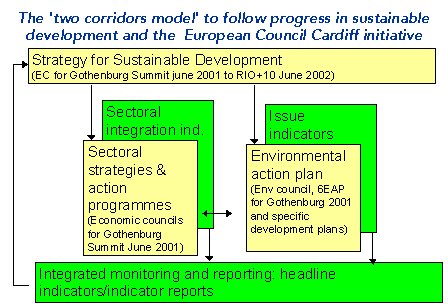
In this model the EU sustainability strategy forms
the chapeau for two parallel lines of policy development: (1) The
environmental issues and environmental policies in a narrow sense are
covered by the development of the 6EAP and the envisaged thematic
plans. (2) The integration process is carried out in the development,
implementation and follow-up of sector environment integration
strategies.
Transparency is achieved by developing in two interlinked "corridors”
sectoral strategies and the 6th Environmental Action
Programme, which should outline a clear long-term vision for policy
making. Accountability is enhanced because behind each of the
strategies indicators and reporting mechanisms are foreseen to
regularly report on progress or lack of progress in the reaching of the
aims and targets of the strategies.
Overall monitoring of progress made in both policy ‘corridors' using a
selected number of, so called, headline indicators, completes the
policy cycle.
From Lisbon to Stockholm
The Lisbon summit in March 2000 on employment, economic
reform and social cohesion (a Europe based on innovation and knowledge)
was the next step in making sustainable development more concrete. Some
spin offs:
- In March in the European Parliament President Prodi made a call for
an integrated approach including economic and social aspects. The
Parliament called for a single report on the economic and social
situation. The environmental dimension was still overseen here,
however.
- In September 2000 the Commission adopted its Communication on
Structural Indicators. It includes a set (27, and 11 to be developed)
of socio-economic indicators around the themes Employment, Innovation,
Economic reform, and Social cohesion. Energy efficiency is included,
but no other aspects of the environment.
- The aim of these would be to progress of the EU "… capable of
sustainable economic growth with more and better jobs and greater
social cohesion” A first report will be delivered to the Stockholm
summit before Gothenburg.
- Commissioner Solbes mentioned in a speech "the indicators provide
an instrument for monitoring, benchmarking and peer pressure which are
vital elements of the Lisbon follow-up strategy”. His technical
arguments for the choice are in line with the "state of art” rules for
using information in policy processes: comprehensiveness -- discipline
- continuity -- learning by doing in an ongoing process.
- As was mentioned before, at the Stockholm European Council the
intention was expressed to join the Lisbon process with the
Sustainability Strategy.
From an operational point of view the merging of the economic and
social dimensions with the environmental dimension brings us to a
hypothetical "three corridors” model (fig. 3):
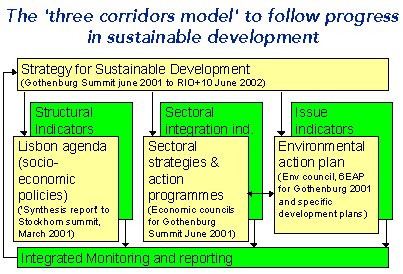
Figure 3:
If this model is implemented it may help not only
to reduce the inconsistency between environment and economic and
sectoral policy but also between those polices themselves (such as
between energy, transport, agriculture and fiscality), and it could
show that the environmental sustainability part is the area which is
maybe the most advanced in terms of accountability.
From Stockholm to Gothenburg
The European Council in its meeting on 23-24 March in
Stockholm concluded: "Lisbon has successfully integrated economic
and social matters. The sustainable development strategy, including the
environmental dimension, to be adopted at the Göteborg European Council
in June will complete and build on the political commitment under the
Lisbon strategy. All dimensions of sustainable development should be
reviewed in the context of the annual Spring European Council.
The European Council will accordingly review at its Spring
meeting in 2002:
- progress in integrating the sustainable development aims into
the Lisbon strategy;
- the contribution that the environment technology sector can
make to promoting growth and employment.”
It is now up to the Gothenburg meeting to put flesh
on the bones of the sustainability strategy. At Gothenburg objectives
should be set out for sustainable development. Unsustainable trends
like in transport and energy use and land use, that can endanger the
long-term perspective of a competitive, knowledge-based and inclusive
society, should be identified and tackled. Ageing populations will
challenge social protection and healthcare systems and may reduce the
room for manoeuvre in budgetary policy. Synergies in creating a safe
and sustainable living environment should be identified. The
same holds for food safety and agriculture. A potential widening of the
income gap in knowledge economies might be counteracted by enhancing
environmentally friendly jobs. The strategy may want to put forward
typically environmental policy instruments like taxation - aimed at
getting prices right to reflect better the costs of environmental
degradation and offer incentives for change.
Also a "three corridors model” for policy making
for sustainable development must be accompanied by interlinked
indicators. As the main policy activities are happening within each of
the corridors, the most logical approach would be to derive part of the
overall EU sustainability (headline) indicators from the existing
initiatives, and then accompany them with some crosscutting ones.
4. Clear structures are needed for making indicators
work
Assuming that policy developers in the EU aim at a
rational and efficient set of policies we may expect that under the
sustainable development strategy a number of interlinked and mutually
supporting policies emerge.
Speaking from the side of those who provide information to support
policy making, I would like to sketch how we see progress reporting and
assessment of such an integrated set of policies developing.
Clear structures are needed to communicate to
policy makers how the information that we provide is related to policy
processes and to make clear what type of information serves which
process.
Complementary to the ‘corridors' in strategic
policy making, clusters of environmental indicators are being developed
(fig. 4).
Figure 4:
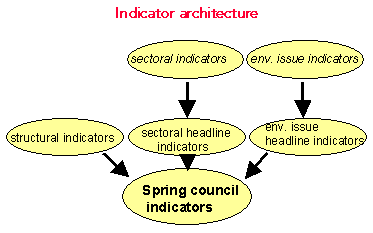
The sectoral integration
strategies (sectoral sustainability) need to be monitored
using indicators for the integration of environment and sectoral
policies. The Transport and Environment Reporting Mechanism as
developed by the EEA with support of Eurostat and the Commission is a
good example for these (see box 1). The EEA is now, together with its
partners, developing similar reports for Energy and Agriculture. Within
the limited capacities of the EEA our focus for the coming years will
be on these three sectors, whereby the analysis progressively will
include more economic and social elements. However, attention is needed
for a good co-ordination between all sectoral reporting mechanisms,
developed either by others or by the EEA with additional support. The
recently published proposal for indicators for enterprises, for
example, is out of scope with the whole system. An EEA publication
providing a common framework for reporting on the conventional sectors
is in preparation[1].
Similar to the ‘environmental headline indicators
(see below) a limited set of main indicators should be selected from
the currently around 30 integration indicators per sector.
|
Box 1 : The TERM process and concept: a model to be followed
by other sectors?
The Amsterdam Treaty identifies integration of
environmental and sectoral policies as the way forward to sustainable
development. The European Council, at its Summit in Cardiff in 1998,
requested the Commission and the transport ministers to focus their
efforts on developing integrated transport and environment strategies.
At the same time, and following initial work by the European
Environment Agency on transport and environment indicators, the joint
Transport and Environment Council invited the Commission and the EEA to
set up a Transport and Environment Reporting Mechanism (TERM), which
should enable policy-makers to gauge the progress of their integration
policies.
The main output of TERM is a regular
indicator-based report through which the effectiveness of transport and
environment integration strategies can be monitored. The first
indicator report --was published in 2000. TERM-2001 is currently under
preparation (publication expected in September 2001).
The TERM indicators were selected and grouped to
address the seven key questions:
- Is the environmental performance of the transport sector
improving?
- Are we getting better at managing transport demand and at improving
the modal split?
- Are spatial and transport planning becoming better coordinated so
as to match transport demand to the needs of access?
- Are we optimising the use of existing transport infrastructure
capacity and moving towards a better-balanced intermodal transport
system?
- Are we moving towards a fairer and more efficient pricing system,
which ensures that external costs are internalised?
- How rapidly are improved technologies being implemented and how
efficiently are vehicles being used?
- How effectively are environmental management and monitoring tools
being used to support policy and decision-making?
The TERM indicator list was developed after consultation with
various Commission services, national experts, other international
organisations and researchers. The indicators cover all the most
important aspects of the transport and environment system
(Driving forces, Pressures,
State of the environment, Impacts,
and societal Responses -- the so-called DPSIR
framework) and include eco-efficiency indicators.
The current list is a long-term vision of an ‘ideal' list and some
of the proposed indicators could not at this stage be quantified. Where
data availability has prevented an EU 15 analysis, national examples or
proxy indicators are used.
The TERM process is steered jointly by the Commission (DG TREN, DGENV,
Eurostat) and the European Environment Agency. The Member States and
other international organisations are consulted regularly.
Source: EEA, 2001, TERM 2001: indicators tracking transport and
environment integration
|
The 6th environmental action
programme and envisaged specific action plans to achieve
environmental sustainability need to be monitored using sets of
selected issue indicators. The EC Communication (COM(2001)31) which
includes the 6th Environmental Action Programme and a
proposal for a Council decision, tries to establish not only the
environmental sustainability pillar of an upcoming EU sustainable
development strategy, but also pays attention to the necessary
monitoring and reporting. The EEA is currently developing proposals for
indicators on the environmental issues in the 6th EAP, which
will find their way into our publications. EEA's Environmental signals
report series will develop into the main indicator report on
environmental sustainability.
While it is still open how the Decision will define
finally the system to monitor progress and implementation of the
6th EAP, we can identify what can be the EEA contributions
based on the EEA ongoing information and reporting system (see Box
2).
|
Box 2 : EEA contributions to the 6th Environmental Action
Programme of the European Communities
1. Monitoring Progress (benchmarking and
accountability)
Yearly reporting (or periodical updating)
- Indicators: ‘Environmental Signals 2000 … 2010'
- Thematic Assessments: ‘Air Quality', ‘GHGE Climate Change'… (on
priority areas)
- Sectoral (integration) assessment: transport, energy, agriculture
…
- Headline indicators (open questions remain)
Pluri-annual reporting
- ‘EU Environment and prospects' - 2004 (for 6th EAP review --
2008)
2. Supporting Policy (specific thematic plans following 6th
EAP)
Framing (prior information/consultation)
- Thematic state-of-environment/state-of-action, to support new EC
initiatives
Implementation (and reporting obligations)
- Thematic … to support EC implementation and enforcement
- Streamlining the monitoring to reporting process (moving from best
available information to best/badly needed information (Bridging the
Gap process). Part of the reporting obligations (e.g. Ozone) ).
3. Dissemination of information including best
practices
For ‘doers': Businesses and Municipalities
- Development of basis for (business/urban) sustainability.
Communication platform on performance reporting; best practices;
indicators; benchmarking; awards.
- Development of thematic interest groups, clearinghouses, pools
(ENVIROWINDOWS)
For experts (and NGOs), public at large
- The EEA Reference Centre. One-stop shop/main-door/portal for EU's
Environmental Information
- The EEA web page
- Educational packages or spin-offs of EEA reporting
|
The European Commission together with the EEA,
Eurostat and the member states will soon publish the first report on
environmental headline indicators (see Box 3). This is
a very limited set of ten indicators for main EU environmental
problems.
Publication of the first report has been delayed due to political
discussions within the Commission, which makes me propose for next
editions a stricter division between the publication of ‘main'
indicators by the EEA (together with Eurostat, at a time when the data
and the assessment become available) followed by a publication by the
Commission of the ‘Headline indicators' in their political context of
developing strategies and implementation plans.
|
Box 3: Environmental headline indicators for the EU
(status January 2001)
|
|
ISSUE
|
CURRENT INDICATORS
|
PROPOSALS FOR IDEAL
INDICATORS
|
|
6th Environmental Action
Programme theme: Climate change
|
|
1. Climate Change
|
aggregated emissions of 3 main greenhouse gases
|
aggregated emissions of 6 greenhouse gases of the Kyoto Protocol
|
|
6th Environmental Action
Programme theme: Nature & biodiversity
|
|
2. Nature & Biodiversity
|
designated "Special Protection Areas” (Birds Directive)
|
biodiversity index, or conservation status of key species and
habitats
|
|
3. Air Quality: acidification
|
aggregated emissions of acidifying substances
|
same
|
|
6th Environmental Action
Programme theme: Environment & human health
|
|
4. Air Quality: summersmog
|
aggregated emissions of ozone precursor substances
|
same, and: number of days of pollution exceeding standards
|
|
5. Urban Air Quality
|
number of days of exceedance (several pollutants)
|
urban air quality indicators or index;
urban transport indicators
|
|
6. Water Quality
|
phosphate and nitrate concentration in large rivers
|
European index for the status of water bodies
|
|
7. Chemicals
|
indicator in development
|
production of hazardous chemicals
|
|
6th Environmental Action
Programme theme: Waste & resources
|
|
8. Waste
|
municipal and hazardous waste generated & landfilled
|
resource use in line with the waste strategy
|
|
9. Resource Use
|
gross Inland Energy Consumption
|
material balance indicator
|
|
10. Water Quant.
|
total fresh water abstraction
|
intensity of water use
|
|
11. Land Use
|
land use by selected categories
|
land use change matrix
|
As has been mentioned before the Commission has
made a proposal (COM(2000)594) for the structural indicators that have
been used in the synthesis report for the Stockholm Council
(COM(2001)97/2 Volume II).
It proposes 27 key indicators, which is considered small enough to
focus the policy debate and be manageable, but sufficiently large to
offer a balanced picture.
No decision has been taken yet on the details of the regular reporting
for future Spring councils incorporating all aspects of sustainability,
which was announced at the Stockholm summit. Regarding the social and
economic indicators a proposal for a short list is given in council
report 6999/01 (see box 4, for this list including a proposal for
adding the environmental dimension).
As there is no institution in the Communities that is able to cover
all three aspects of sustainable development, the creation of a
consortium will be necessary for the organisation of the Spring Council
reporting. In accordance with its current remit and tasks, the EEA can
cover the indicator assessment for the environmental dimension,
including sectoral integration. Eurostat, as main data-source is the
logical provider of the 12 economic and societal indicators, while the
JRC could provide assistance in the integral assessment (which is
currently lacking from the synthesis report).
| Box 4: Proposed indicators
for Spring European Council reporting on sustainable
development
The list of 12 indicators for economy and society
is the following:
General Economic background:
1. GPP (per capita and as growth rate)
Employment
2. employment rate by gender
3. employment rate of older (55-64) workers
Innovation and research
4. R&D expenditure as % of GDP
5. % of citizens with internet access
6. ICT (Information and Communication Technology)expenditures
Economic reform
7. consumer price of telecommunications and electricity
8. business investment as % of GDP
9. capital raised on stock markets as % of GDP
Social Cohesion
10. long term (> 12 months) unemployment rate
11. regional cohesion, expressed as coefficient of variation of
unemployment rate at NUTS 3 regional level
12. share of population aged 18-24 with only lower secondary
education.
And an EEA proposal for the environmental
dimension, including the Cardiff process:
Environment
13. greenhouse gas emissions
14. water quality: nitrogen and phosphorus concentration in large
rivers
15. waste: municipal and hazardous waste quantities, amounts generated
and landfilled
Sector development
16. transport: passenger transport by mode.
17. energy: share of renewables in electricity generation
18. agriculture: total number of cattle and pigs, shown by number per
farm (herd size).
|
Consistency and discipline
In regular indicator based reporting for
whatever purpose or target group consistency and discipline should be
strived for. Consistency is needed in choosing indicators to report on
thematic action programs making sure that sectoral contributions can be
identified. Consistency is needed in the sector-environment reporting
mechanisms to allow for comparing progress between sectors and to be
able to analyse and compare progress in the use of ‘integration'
instruments. Consistency is also needed in the further development of
the ‘headline'-indicators and the development of a merger between the
structural indicators, the environmental headline indicators and the
eventual sectoral headline indicators.
However, there are still some open questions in the
implementation of the whole system:
Regarding the sector integration pillar:
- Will all the sector-economic policies dare
to agree on a package of (consistent) indicators?
- To what extent will sector reporting
mechanisms have to include all dimensions of sustainable
development?
- Will the sectors allow for
external/independent assessment of progress and
benchmarking?
- Will the sectors dare to fix/accept targets
on time (for different indicators)? Either on the strategies or in
related follow-up plans?
Regarding the environmental issues/6EAP pillar?
- Will the 6th EAP during the coming
discussions develop into the reference frame for the environmental
sustainability pillar? And will it become stronger on targets and
indicators to measure progress?
Regarding the socio-economic pillar:
- Will there be a real integration between the
"Cardiff initiative” (towards Gothenburg) and the Lisbon -- Feira
process (towards Stockholm)?
And in relation to this: will the EC proposal on a
sustainability strategy set the model and the process for the three
pillars of sustainable development (social -- economic -- environment)?
And what will be the institutional setting for the development of
(independent) reporting to the Spring Council?
An even more important question for the
implementation is:
- Will countries also develop a similar
transparent structure for monitoring progress in policies? Up to now
the experience with headline and sectoral indicators shows that a
majority of countries is at least hesitant to follow these
developments, although some countries made progress in using overall
sustainability indicators.
Implementing indicators -- an opportunity
or just another burden?
Countries are hesitant to implement monitoring systems based
on indicators for several reasons. Two of the most important are the
perceived additional costs involved with data collection and the
feeling that resulting indicators and assessments could be used as a
"stick” by the Commission against countries for non-compliance with
legislation. The latter is particularly relevant for indicators linked
to policy targets.
It is true that for many of the more "interesting”
indicators, data collection systems do not yet exist in Member States.
This is not because of lack of will in countries, rather the
perceptions that the burden is ever-growing being added to and never
reduced, that little use is made of the information already reported to
EU institutions.
These perceptions, whether correct or incorrect,
present a challenge to all of us involved with using environmental
information in the EU. To overcome these negative, though justified
perceptions, I believe we should consider doing the following positive
steps:
- Firstly, move away from the legalistic
approach between the EU and Member States to data gathering, assessment
and reporting towards a system, using indicators and their assessment,
which focuses on the effect and effectiveness of policies and
measures.
- Streamline current data collection and
reporting systems in Member States and the EU to reflect the shift
above. Work with the Commission to establish a final strategy in this
respect is ongoing. It will take into account the needs regarding
implementation of Community legislation, but also the supply of
information under international conventions. Policy objectives and
information needs will be more explicitly stated so as to identify and
remove current redundancies, and assign clear institutional
responsibilities (see example suggested at top of page 14) so that
duplication of effort is avoided.
- Encourage Member States to use saved
resources to fill some of the gaps in data needs identified for
indicators.
- Make use of EU financial instruments and
research framework programmes to fund development and implementation of
more interesting indicators and methodologies, so enhancing burden
sharing between the Community and Member States.
5. Putting indicators to work
The main envisaged roles for the indicators build
on the experience of the use of GDP and also of the EMU convergence
parameters, that you can only:
- manage what you measure
(indicators)
- respond and be rewarded/penalised for those
things which you can be held accountable
(benchmarking), and
- achieve what has been agreed
(targets).
Critics may say that indicators and targets are a
far too simplistic response to complex issues, but in reality they are
the top of an iceberg of information and more important: they seem to
work!
5.1 Using scorecards, peer pressure,
benchmarking and best experiences
Score cards are overviews of the progress of
countries, cities, companies or other entities based on a number of
well-selected variables. Sometimes scorecards are based on an index
aggregating many different indicators. Their use for comparing the
progress made by countries allows for "naming and faming” for those who
achieved a lot, with the potential for the others to learn from the
experiences, and for "naming and shaming” of those that failed to
achieve progress.
In a still basic form the EEA developed such a scorecard based on its
indicator report Environmental signals 2000 (figure 5)
Figure 5:
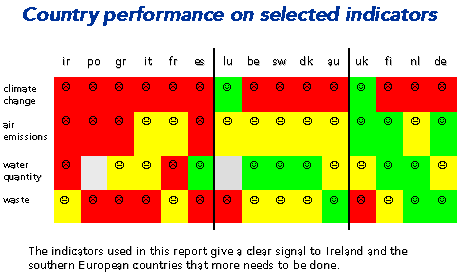
Apart from encouraging countries (or the other
entities compared) to do better, this information provides the entry
point for a benchmarking exercise. In this example (figure 5) the
situation and policies in the countries at the right side should be
explored in detail to see which factors and which levers were
responsible for the good performance. Policy effectiveness indicators
are useful tools for this. Successful measures and policies (the
success stories) should be considered for adaptation and use by others.
Ultimately any collection of indicators should go together with a
system for sharing ‘best experiences'. The EEA is developing the
‘Envirowindows' tool[2] as a mechanism
for decentralised collection and sharing of this information by and for
environmental managers.
5.2 Using convergence criteria
Identifying indicators is a first step towards
agreeing on targets.
As the EMU convergence criteria were able to move EU member states
quickly in the direction of Euroland, sustainability targets should be
able to move societies towards a general improvement of sustainability.
What we need now are sustainability convergence criteria!
The first principle for developing such
sustainability convergence criteria is summarised in the statement:
"For every complex problem there is a simple answer and it is always
wrong”.
Sometimes scientists consider with horror the easy with which policy
makers push a solution for a complex issue. However, when policy makers
are able to agree on simple approximations, then they often work and
lead to faster progress compared to more balanced approaches. Apart
from the EMU convergence criteria, we have seen examples in the use of
the Kyoto target for emissions of a basket of six greenhouse gas, the
negotiations in the framework of the Convention on Long Range
Transboundary Air Pollution using no exceedance of critical deposition
loads as starting point. We should not be afraid to develop some bold
measures and accompanying bold targets.
Secondly use of the sustainable convergence
criteria ask for simplicity, in other words the answer to the question
"what is really important and at stake”. The indicators mentioned in
box 4 (the Spring reporting set) provide a first answer to this
question and invite policy makers to be as specific as possible on the
objectives and targets in each of the areas.
Of course, while this core of indicators and
related targets serves to monitor and benchmark overall progress,
nothing stops us to develop some specific thematic monitoring systems,
if required, when some priority issues are identified politically. This
seems to be the case for the emerging EU Sustainable Development
Strategy and for the 6th Environmental Action Programme
(climate change and clean energy -- management of natural resources --
mobility -- land use and territorial management -- public health --
poverty and social exclusion -- demography and ageing).
The business sector has been especially keen on
answering the question ‘What is really important', to be able to use
environment like other criteria in business management. As many of the
"new” approaches such as benchmarking, steering by indicators, etc.
stem from business management and financial accounting, it is no wonder
that the business sector has applied these tools also for environmental
and sustainability issues. Few people are aware of this progress and
government administrations certainly can learn from the companies. This
interaction between companies and government could even lead to a
re-inforced co-operation in the field of the environment and
sustainability.
Companies at the forefront of sustainability thinking have joined
together in the World Business Council for Sustainable Development,
wouldn't it be an idea for national states to join in a similar club of
Member States for sustainability?
Progressive parts of the business sector are now
formulating sustainability convergence criteria to have a clear target
for their companies, to be able to benchmark and the monitor progress
(Figure 6). It is now up to national governments and the EU to develop
their sustainability strategies in a similar clear and transparent
process, to achieve the progress needed with the involvement of all
stakeholders.
Figure 6: WBCSD sustainability
convergence criteria
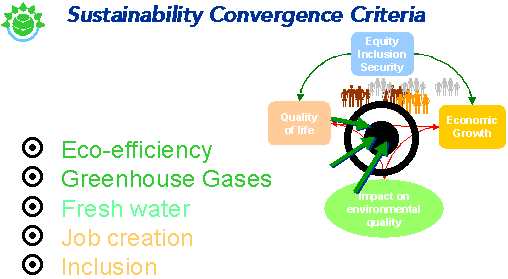
[1]
Common framework for indicator based reporting on sector-environment
integration. Technical report EEA.
[2] via the EEA homepage http://www.eea.europa.eu under
services.







Document Actions
Share with others